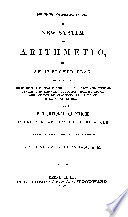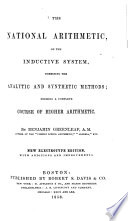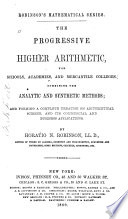 | Roswell Chamberlain Smith - Arithmetic - 1856 - 334 pages
...then, 25-=-5=5years, the common difference. A. 5 years. 11. Hence, to find the common difference, — Divide the difference of the extremes by the number of terms, less 1, and the quotient Witt te the common difference. 12. If the extremes be 3 and 23, and the number... | |
 | Benjamin Greenleaf - Arithmetic - 1857 - 452 pages
...extremes, 45 — 3 = 42, divided by the number of common differences, 21, gives 2 as the common difference required. RULE. — Divide the difference of the extremes by the number of terms less one, and the quotient will be the common difference. EXAMPLES. 2. A certain school consists of 19 teachers... | |
 | Benjamin Greenleaf - Arithmetic - 1857 - 336 pages
...quotient will be the common difference. Thus, 27 -S- 9 = 3, the common difference. Hence the following RULE. — Divide the difference of the extremes by the number of terms less one, and the quotient is the common difference. EXAMPLES FOR PRACTICE. 1. The extremes of a series are 3... | |
 | James Stewart Eaton - Arithmetic - 1857 - 376 pages
...Hence, 346. PROB. 2. — The extremes and number of terms being given, to find the common difference, RULE. — Divide the difference of the extremes by the number of terms less one, and the quotient will be the common difference. Ex. 1. The extremes of an arithmetical series are 5... | |
 | Charles Guilford Burnham - Arithmetic - 1857 - 328 pages
...238* — When the extremes and number of terms are given, to find the common difference, we have this RULE. Divide the difference of the extremes by the number of terms less 1, and the quotient will be the common difference. 7. If the first term of a series be 3, the last... | |
 | Benjamin Greenleaf - Arithmetic - 1858 - 456 pages
...the number of common differences, 21, gives 2 as the common difference required. RULE. — Dh-itle the difference of the extremes by the number of terms less one, and the quotient will be the common difference. EXAMPLES. 2. A certain school consists of 19 teachers... | |
 | Horatio Nelson Robinson - Arithmetic - 1859 - 348 pages
...one ; thus, by taking away 2 in the fifth term, 2-J-3 + 3 + 3 + 3, we have 3 taken 4 times. Hence, RULE. Divide the difference of the extremes by the number of terms less one. EXAMPLES. 1. The first term is 2, the last term is 17, and the number of terms is 6 ; what is the common... | |
 | Silas Lawrence Loomis - Arithmetic - 1859 - 324 pages
...PROB. CLIII. — GIVEN, THE EXTREMES AND NUMBER OF TERMS, TO FIND THE COMMON DIFFERENCE AND MEANS. RULE Divide the difference of the extremes by the number of terms, less one, for the common difference. Then construct the series by P/ob. CL. PROB. CLIV. — GIVEN, THE EXTREMES... | |
 | Benjamin Greenleaf - Arithmetic - 1860 - 456 pages
...extremes, 45 — 3 = 42, divided by the number of common differences, 21, gives 2 as the common difference required. RULE. — Divide the difference of the extremes by the number of terms less one, and the quotient will be the common difference. EXAMPLES. 2. A certain school consists of 19 teachers... | |
 | Horatio Nelson Robinson - Arithmetic - 1860 - 444 pages
...equal to the common difference multiplied by the number of terms less 1, (706), we have the following RULE. Divide the difference of the extremes by the number of terms less 1. EXAMPLES FOR PRACTICE. 1. If the extremes of an arithmetical series are 3 and 15, and the number... | |
| |